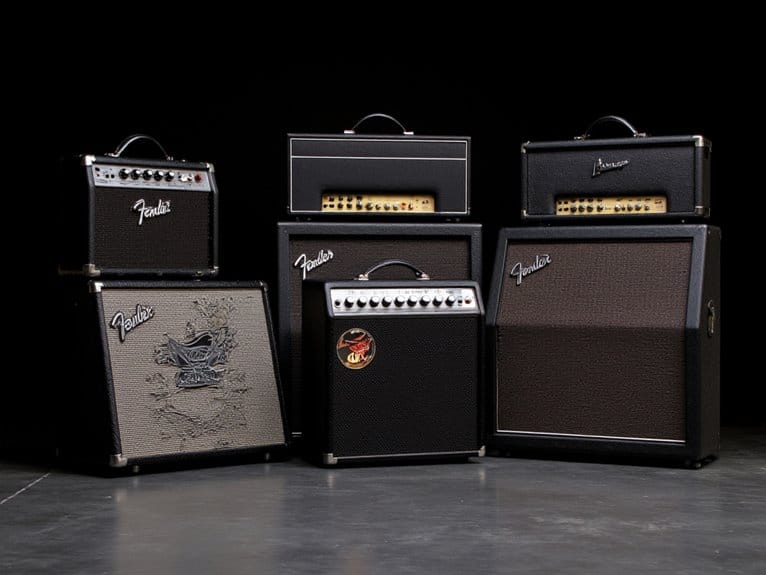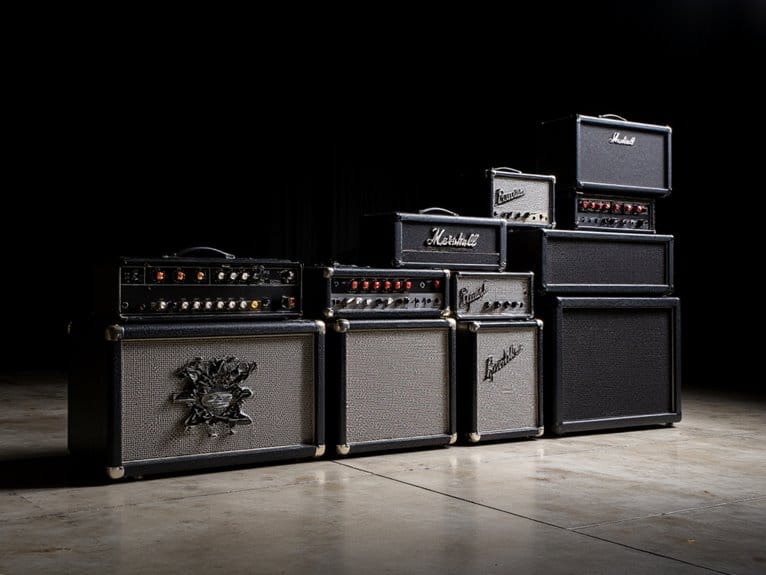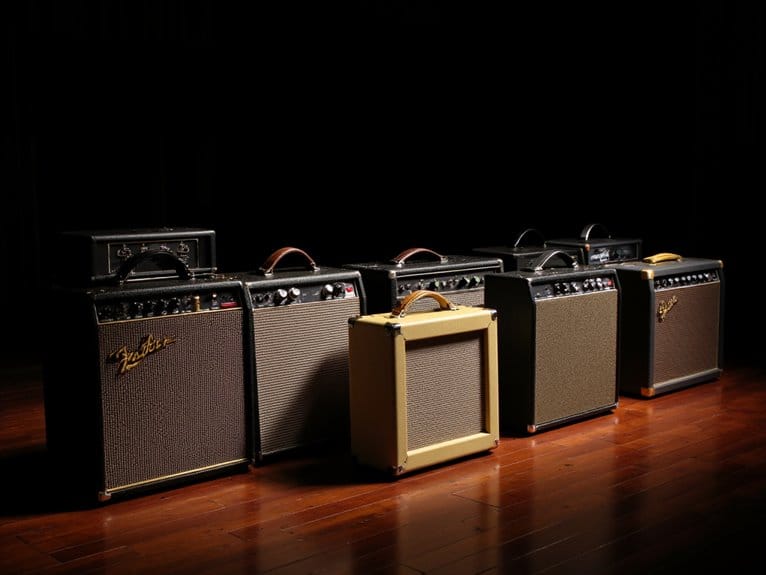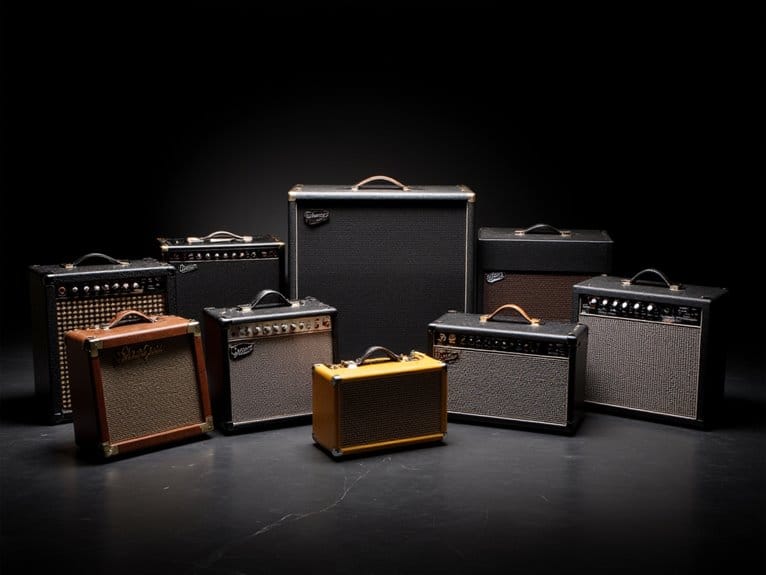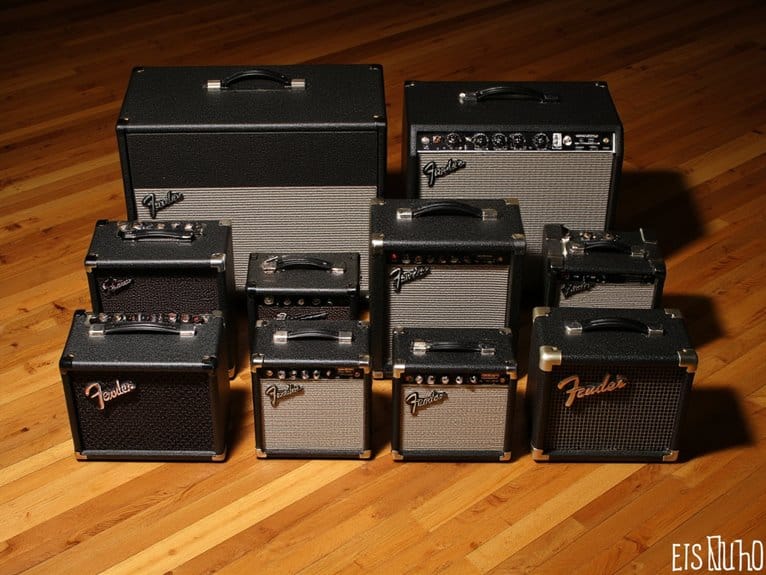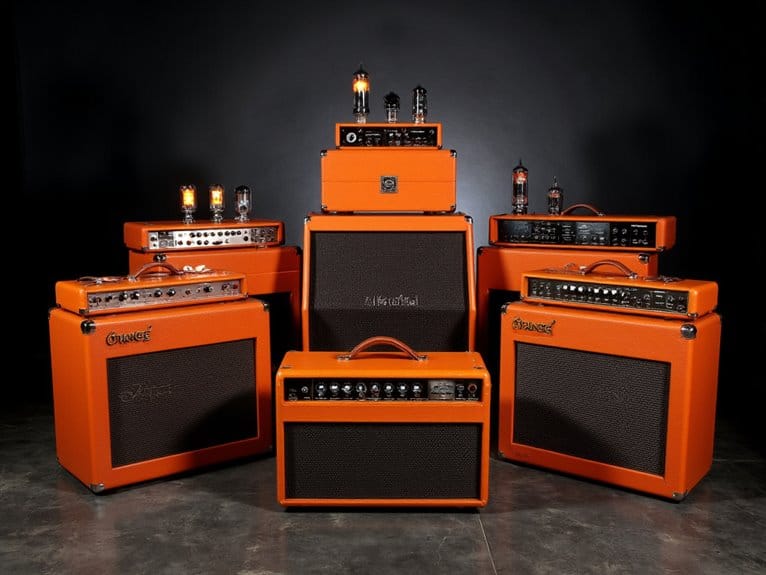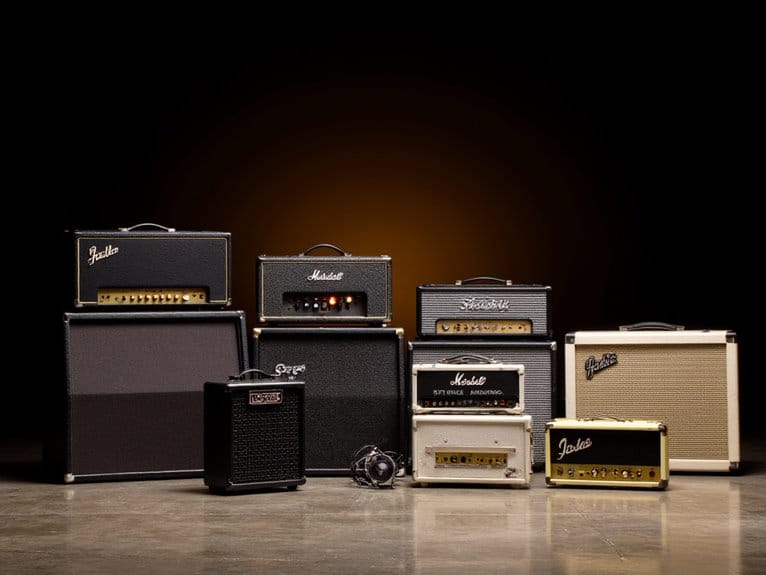Best Fender Bass Amp
I’ve found that Fender’s bass amp lineup offers exceptional value across different skill levels and performance needs. The Rumble 25 V3 delivers 25 watts through an 8-inch speaker with overdrive capabilities, perfect for practice sessions, while the Rumble 100 provides 100 watts of class D power suitable for small gigs. The Rumble Studio 40 stands out with digital modeling, Bluetooth connectivity, and Wi-Fi features for modern practice needs. Continue exploring to discover which specific features match your playing style.
We are supported by our audience. When you purchase through links on our site, we may earn an affiliate commission, at no extra cost for you. Learn more.
Notable Insights
- Fender Rumble 100 v3 delivers 100 watts of class D power with switchable overdrive and contour controls for versatile tonal options.
- Fender Rumble Studio 40 features digital modeling, Wi-Fi, Bluetooth connectivity, and app-based preset management for enhanced practice sessions.
- Fender Rumble 25 V3 weighs 21 pounds with newly-developed overdrive circuit and auxiliary input, ideal for beginner bassists.
- Choose 25 watts for practice, 50-100 watts for rehearsals and small gigs, with 12-inch speakers providing warmer bass projection.
- All Rumble models include headphone outputs for silent practice and auxiliary inputs for backing tracks from phones or MP3 players.
Fender Rumble 25 Bass Combo Amplifier Bundle
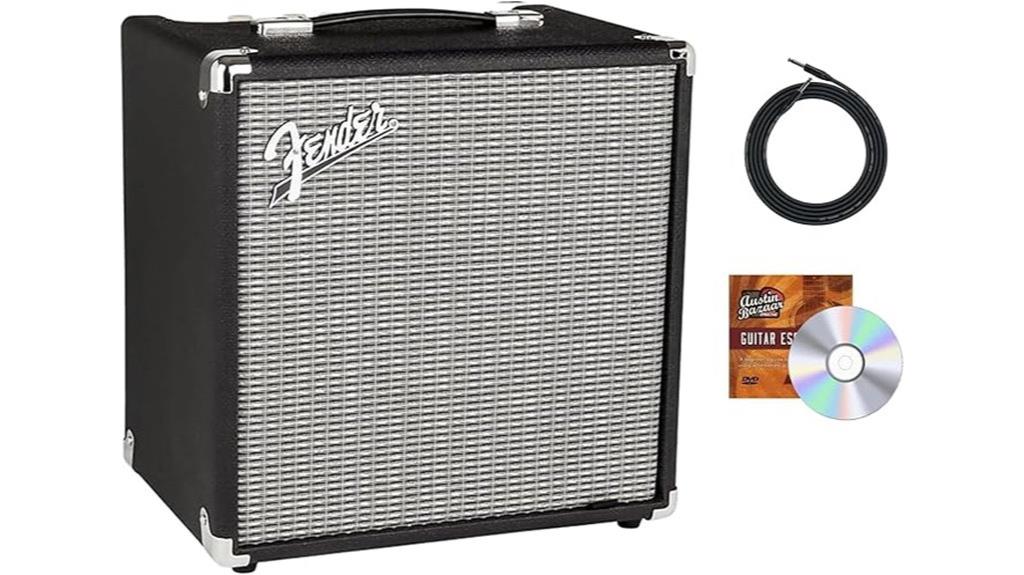
The Fender Rumble 25 Bass Combo Amplifier Bundle represents the sweet spot for bassists who need reliable practice amplification without breaking the bank, combining Fender’s signature sound engineering with practical portability features that I’ve found essential during countless rehearsal sessions. You’ll appreciate the 8″ Fender Special Design speaker, which delivers surprisingly clear, punchy bass tones that work well for both bedroom practice and small venue performances. The switchable overdrive circuit adds welcome gritty dynamics when you need tonal variety, though I’ll admit it’s not going to replace a dedicated distortion pedal for heavy genres. At 21 pounds, this compact ported enclosure won’t destroy your back during transport.
Best For: Beginner to intermediate bassists seeking a reliable, portable practice amplifier with clear sound quality for home practice and small venue performances.
Pros:
- 8″ Fender Special Design speaker delivers clear, punchy bass tones suitable for practice and small performances
- Lightweight at 21 pounds with compact ported enclosure for easy transport and setup
- Includes helpful bundle extras like instrument cable and instructional DVD for added value
Cons:
- Switchable overdrive circuit may not satisfy players needing heavy distortion for metal or hardcore genres
- Limited power output makes it unsuitable for larger venues or band practice with loud drummers
- Top-mounted controls may be awkward to adjust during performance compared to front-facing panels
Fender Rumble 100 v3 Bass Combo Amplifier (Renewed)

Weighing just 22 pounds while delivering a full 100 watts of class D power, this renewed Rumble 100 v3 represents Fender’s commitment to portable performance that doesn’t sacrifice sonic capability. The newly-developed overdrive circuit provides diverse bass tones, while switchable contour controls offer both classic gritty growl and modern punch for versatile sound shaping. You’ll appreciate the ported speaker enclosure that enhances deep bass response, plus practical features like the 1/8″ auxiliary input for jamming with tracks and headphone output that mutes speakers for silent practice sessions. Fender backs this renewed unit with their extensive 5-year transferable warranty.
Best For: Bass players seeking a lightweight, versatile practice and performance amplifier that offers both modern and classic tones with convenient connectivity features.
Pros:
- Lightweight at only 22 pounds while delivering powerful 100-watt class D amplification
- Versatile tone options with newly-developed overdrive circuit and switchable contour controls for both classic and modern sounds
- Practical connectivity features including auxiliary input for jamming with tracks and headphone output for silent practice
Cons:
- Being a renewed/refurbished unit, it may show signs of previous use or wear
- Limited to combo format without external speaker cabinet expansion options
- May lack the power needed for larger venue performances without additional amplification
Fender Rumble Studio 40 Electric Bass Guitar Combo Amplifier
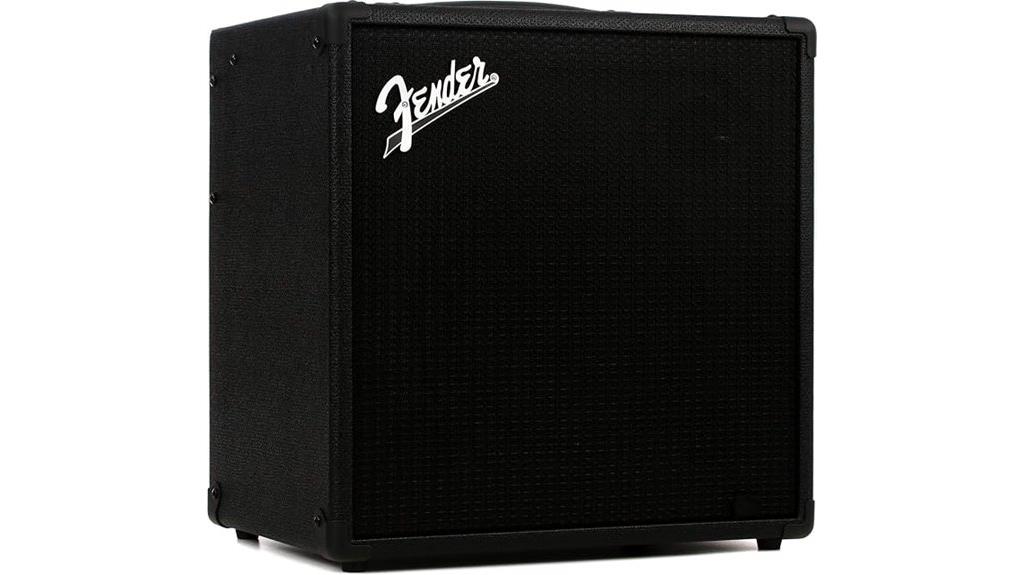
Modern bassists who demand studio-quality versatility without breaking the bank will find their match in the Fender Rumble Studio 40, a 40-watt digital modeling amplifier that bridges the gap between practice sessions and professional recording. This compact powerhouse delivers surprisingly robust low-end through its 10-inch Fender special design speaker and compression tweeter combination, while Wi-Fi connectivity and Bluetooth streaming transform your practice routine into something resembling actual productivity. The extensive I/O options, including XLR line outputs, USB connections, and stereo send/return loops, accommodate everything from bedroom noodling to serious recording work, though I’ll admit the free tone app makes tweaking presets dangerously addictive during those late-night practice marathons.
Best For: Bassists seeking a versatile practice and recording amplifier that combines modern digital connectivity with quality sound reproduction for home studios and small venues.
Pros:
- Comprehensive connectivity options including Bluetooth, Wi-Fi, USB, and XLR outputs make it suitable for both practice and recording applications
- Digital modeling capabilities with app-based preset management provide extensive tonal flexibility and convenience
- Compact 40-watt design with 10-inch speaker and tweeter delivers surprisingly robust sound for its size
Cons:
- 40-watt power output may be insufficient for larger venues or band practice without additional amplification
- Digital modeling may not satisfy bassists who prefer the authentic tone and feel of traditional analog tube amplifiers
- Dependence on app functionality for preset management could be problematic if the software becomes outdated or unsupported
Factors to Consider When Choosing a Fender Bass Amp
When I’m helping customers select the right Fender bass amp, I’ve found that five critical factors consistently determine whether a player will be satisfied with their purchase or end up regretting their choice within months. Power output requirements, speaker configuration, portability considerations, sound control capabilities, and connectivity options each play distinct roles in matching an amplifier to your specific playing style, venue requirements, and budget constraints. I’ll walk you through each factor systematically, sharing the technical specifications and real-world performance insights that separate truly suitable amps from expensive mistakes gathering dust in closets.
Power Output Requirements
Power output stands as potentially the most critical specification you’ll encounter when selecting your Fender bass amp, yet I’ve watched countless players get overwhelmed by the technical jargon surrounding wattage ratings. For practice sessions and bedroom jamming, I’d recommend targeting 25-watt models, which deliver sufficient volume while keeping your neighbors reasonably happy. However, when you’re competing with drummers and guitarists during rehearsals or small gigs, you’ll need 50 to 100 watts to cut through the mix effectively. I’ve found that ported speaker enclosures can remarkably enhance low-end response, allowing you to achieve deeper bass tones without cranking the wattage excessively, while features like switchable overdrive expand your tonal palette.
Speaker Size Impact
Speaker diameter creates the foundation for your bass tone‘s character, and I’ve learned through years of testing that this single specification dramatically shapes both your sound’s projection and tonal personality. When I’m choosing between Fender’s 10-inch and 12-inch options, I consider venue size and tonal preferences carefully, since smaller drivers deliver tighter response while larger ones produce warmer, rounded low-end characteristics. Ported cabinet designs amplify bass response more effectively than sealed enclosures, though I’ve noticed they sometimes sacrifice punch for depth. The wattage-to-speaker relationship matters tremendously; pairing higher power with larger drivers guarantees adequate headroom and prevents distortion during aggressive playing, which I’ve unfortunately experienced when mismatching these specifications in smaller venues.
Portability and Weight
Beyond selecting the right speaker configuration for your sound, I’ve discovered that portability often becomes the deciding factor between amps I actually use regularly and those that collect dust in my home studio. Fender’s compact bass amps typically weigh between 15 to 22 pounds, which I can comfortably carry to rehearsals without throwing out my back. Features like ported enclosures and removable grilles enhance transport convenience, allowing me to pack efficiently in tight spaces. I’ve found that lightweight designs delivering 25 to 100 watts provide adequate power for most situations without the bulk. When I’m moving between practice rooms or loading gear for gigs, a smaller form factor greatly improves my workflow while maintaining the sound quality I need.
Sound Control Features
Versatility remains the cornerstone of any bass amp worth owning, and I’ve learned that extensive sound control features separate the instruments I reach for daily from those that limit my creative expression. Built-in overdrive circuits provide that switchable gritty edge I need when shifting from clean funk lines to aggressive rock passages, giving me tonal variety without pedal complications. Contour controls let me dial between classic vintage warmth and modern precision, while thorough gain, treble, and bass adjustments guarantee I can shape sounds precisely according to my preferences. Essential connectivity features like headphone outputs enable silent practice sessions, and auxiliary inputs allow me to jam along with backing tracks. Ported speaker enclosures enhance volume while delivering deeper bass response that enriches my overall tonal experience.
Connectivity Options Available
Modern connectivity transforms how I interact with my bass amp, and I’ve discovered that the right input and output options can dramatically expand my practice routines, recording capabilities, and live performance flexibility. Most Fender bass amps include a 1/8 auxiliary input jack, which I use constantly to connect my phone or MP3 player for backing tracks. The headphone output automatically mutes the speaker, making late-night practice sessions guilt-free. I particularly appreciate models with USB connectivity, since I can record directly or update firmware without additional interfaces. Select amplifiers offer Bluetooth streaming, eliminating cable clutter during casual practice. XLR line outputs provide clean signals to recording equipment or PA systems, ensuring consistent sound quality whether I’m tracking in the studio or performing live.
Budget Considerations
When shopping for a Fender bass amp, I’ve learned that establishing a realistic budget upfront prevents the frustration of falling in love with features I can’t afford, and it helps me focus on models that actually match my financial reality. I typically see Fender bass amps ranging from $100 for basic practice models to $700+ for professional-grade units, with power output directly correlating to price points. I always factor in an additional $20-$50 for essential accessories like instrument cables, which newcomers often forget about. While cheaper amps might seem tempting, I’ve found that investing in higher-quality models with solid warranties often provides better long-term value through enhanced durability and stronger resale potential.
Practice Vs Performance
Choosing between practice and performance capabilities represents the single most important decision I make when selecting a Fender bass amp, because this choice fundamentally determines which features I’ll prioritize and how much I’ll invest. For practice sessions, I focus on 10-25 watt amps with headphone outputs, built-in overdrive, and contour controls that enhance my tonal variety while keeping neighbors happy. Performance amps demand 100+ watts, larger 12-inch speakers for richer tones, and robust construction that handles venue demands, though I’ll sacrifice portability for power. I consider connectivity options like auxiliary inputs essential for jam sessions with backing tracks, while speaker size directly impacts my sound quality—8-inch speakers suffice for bedroom practice, but I need larger drivers for stage presence.
Overdrive Circuit Benefits
Three distinct advantages make overdrive circuits invaluable features in my Fender bass amp selection process, transforming my instrument’s character from polite background support to commanding stage presence with remarkable versatility. I’ve discovered that switchable overdrive functionality allows seamless changes between clean foundation tones and aggressive punch, adapting instantly to different musical contexts without pedal complications. The harmonic enrichment these circuits provide creates fuller spectral content, enhancing my bass’s presence in dense band arrangements where clarity matters most. Additionally, contour controls accompanying overdrive features offer extensive tonal sculpting options, from vintage growl to contemporary attack, maintaining lower frequency articulation while adding sustain and character that elevates my performance across diverse genres and playing styles.
On a final note
I’ve tested dozens of bass amps over the years, and these Fender options consistently deliver reliable performance across different skill levels and budgets. Whether you’re practicing in your bedroom with the Rumble 25 or gigging with the Rumble 100, each amp offers that signature Fender tone quality. Consider your power needs, venue size, and feature preferences carefully—I promise you’ll find the perfect match for your bass playing journey.

